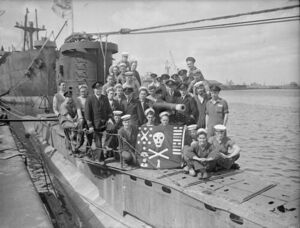Operation Flyhook
This article is a work-in-progress because it is incomplete and pending further input from an author. Note: The contents of this article are not considered canonical and may be inaccurate. Please comment on this article's talk page to share your input, comments and questions. |
The Small Cronan Sea War, officially Operation Flyhook or amongst Arcer submariners 'The Capetian Vacation,' was a period during the Second Great War during which Arcer submarines and their allies attacked Capetian merchant shipping and naval surface vessels along the Capetian Peninsula and in the Polynesian Sea. The engagement lasted the duration of the Second Great War, with several distinct phases occuring due to technological advancements or fluctuations in the course of the war's fighting.
| Operational Flyhook | |||||||
|---|---|---|---|---|---|---|---|
| Part of the Cronan Theatre | |||||||
 Arcer submariners preparing to conduct a patrol in the Polynesian Sea. | |||||||
| |||||||
| Belligerents | |||||||
|
|
| ||||||
| Commanders and leaders | |||||||
|
| |||||||
| Units involved | |||||||
| Royal Arcerion Submarine Service |
Capetian Navy Various Marine Merchantmen | ||||||
| Strength | |||||||
| Several submarine flotillas | Hundreds of surface vessels including escorts, merchantmen, and freighters | ||||||
| Casualties and losses | |||||||
|
| |||||||
The campaign lasted nine years, with the first engagements by Arcer submarines beginning just a few short weeks after the war's announcement, as it was part of Operation Forefront, the larger Arcer naval campaign in South Crona, the Songun and Polynesian Seas. Weak and disparate Capetian leadership early in the campaign meant that triple-digit losses were recorded of Capetian shipping with a number of notable surface vessels sunk.
Due to the lack of direct engagement by Arcer surface vessels against their Capetian counterparts, this portion of the conflict is considered the most dynamic and directly involved portion of the war on the naval side, as the Army and Air Force were embattled under Operation Lightfoot with their Paulastran allies.
Background
Campaign
Public Responses
Arcerion
The Cape
See Also
Existing Lore:
During the Second Great War Acer submarines saw extensive action against The Capetian Navy, operating in the Songun Sea and the Polynesian Sea. This was part of the larger Arcer naval mission to deny the Capetian Navy freedom of navigation and freedom of movement in the Songun sea, as well as conduct sea lane denial and commercial raiding to prevent the Cape from receiving the necessary materials and supplies it required to sustain its own war effort. Arcer submarines achieved the most success, as the Arcer surface fleet and Capetian Navy's capital ships never engaged directly in a major battle, the largest being a few smaller flotilla-sized actions between groups of escort ships that happened to make chance contact. Submarines operated under the umbrella mission of Operation Forefront, however under the command of Rear Admiral Lawrence Arthur Coxley, who was acting as Commander, Submarine Force, the Arcer Subsurface fleet operated under Operation Flyhook, which was the sea lane denial, commerce raiding, and minelaying conducted by the submarine force at this time.
Overall, Arcer submarines achieved great effect, sinking dozens of Capetian, Caphirian, and Corummese-flagged merchantmen, as well as a number of smaller Capetian warships of corvette and frigate-size. Moderate damage was done to Capetian major capital ships, although none were sunk, just forced into shipyards for repairs. During the war, four Arcer submarines were damaged by enemy fire or anti-submarine warfare, and an additional two were lost. His Majesty's Arcer Submarine Superior, was destroyed by enemy surface vessels, likely due to depth charges and being unable to surface in 1951. HMAS Typhoon was lost with all hands during an emergency dive rehearsal as part of crew training in the Malentine Sea, where it sunk to 300 meters and was destroyed. The legacy of the war continues to influence modern Arcer submarine doctrine. An emphasis on torpedo and mine warfare are consistently emphasized as the most important aspects of the Service's capabilities, and while it maintains the ability to launch cruise missiles and anti-ship missiles, these are considered of secondary nature.